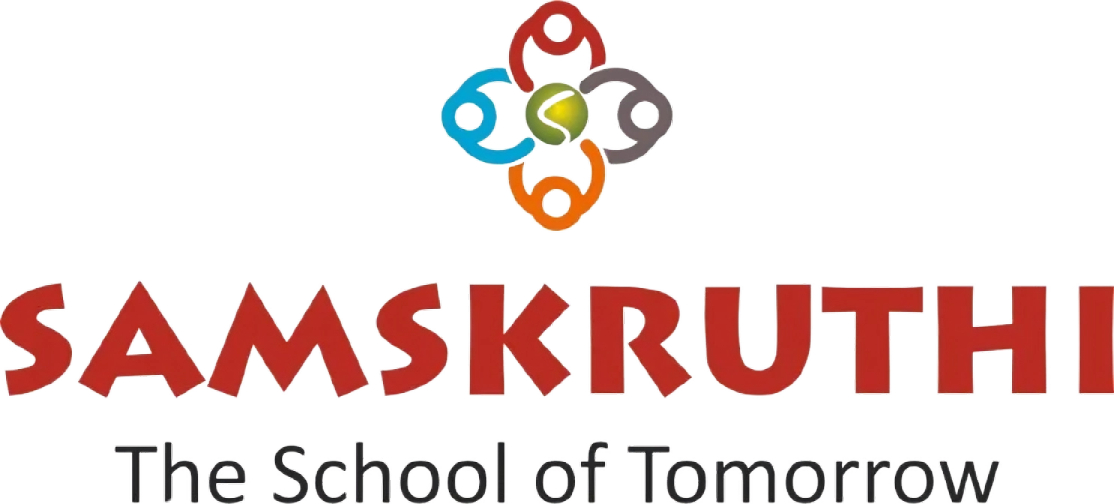CBSE Curriculum
CBSE Curriculum
At Samskruti International School, we provide a wide array of facilities that support the overall development of our students, ensuring their academic, physical, emotional, and cultural growth. Here’s an overview of our key facilities:
Overview
The CBSE envisions a robust, vibrant and holistic school education that will engender excellence in every sphere of human endeavor. The Board is committed to providing quality education to promote intellectual, social and cultural vivacity among its learners. It works towards evolving a learning process and environment, which empowers the future citizens to become global leaders in the emerging knowledge society. The Board advocates Continuous and Comprehensive Evaluation with an emphasis on the holistic development of learners. The Board commits itself to provide a stress-free learning environment that will develop competent, confident and enterprising citizens who will promote harmony and peace.
Subject Areas
| For Pre-Primary | For Grades 1 & 2 | For Grades 3, 4, 5, 6 7, 8, 9 & 10 |
|---|---|---|
| English | English | English |
| Mathematics | Mathematics | Mathematics |
| EVS | EVS | Science |
| GK | ICT | Social |
| Second Language: Hindi/Telugu | Second Language: Hindi/Telugu | Second Language: Hindi/Telugu |
| ICT | Robotics |
Teaching Methodology
For Pre-Primary and Grades 1 & 2, Visible Thinking Routines are practiced at Samskruti to promote and enhance student learning. These routines enrich the classroom environment and foster students’ intellectual development. They help students reflect on their thinking about a topic or issue and explore how and why their thinking has changed. Classroom routines for developing language, mathematical concepts, and a sense of belonging ensure that essential tasks are completed daily or weekly.
With these routines in place, students are aware of what is expected of them.
For Pre-Primary and Grades 3 to 10, research-based projects are assigned in all subjects. The Assessment of Speaking and Listening helps improve and standardize students’ communication skills. Extensive research-based projects are carried out in diverse subjects such as Mathematics, Science, Social Science, and English.
Flipped classroom strategies have also been implemented at Samskruti, reversing the traditional classroom model to enhance student-centered learning and achievement. Students are also given a platform to nurture their talents through subject-specific events.
Integrated and Interdisciplinary Curriculum:
Beyond classroom teaching, the curriculum integrates practical work, guest lectures, field trips, and project-based learning, providing a rigorous academic experience with immersive global exposure.
Learning concepts are reinforced through engaging activities that align with the CCE (Continuous and Comprehensive Evaluation) pattern of CBSE. Smart Class Technology further bridges the gap between classroom learning and real-world applications.
ASSESSMENT
Assessment for CBSE classes is based on the Continuous and Comprehensive Evaluation (CCE) system. The CCE scheme refers to a school-based evaluation method that assesses all aspects of a student’s development.
Continuous assessment involves regular evaluations, frequent unit testing, analysis of learning gaps, application of corrective measures, retesting, and providing feedback to both teachers and students for self-evaluation.
Comprehensive assessment, on the other hand, covers both scholastic and co-scholastic aspects of a student’s growth and development. These are evaluated through Formative and Summative Assessments.
Formative Assessment in CBSE:
Formative Assessment is a tool used by teachers to continuously monitor student progress in a non-threatening, supportive environment. It involves:
Regular descriptive feedback, allowing students to reflect on their performance, take advice, and improve.
Active student participation, where students are involved in designing assessment criteria and evaluating themselves or their peers.
When implemented effectively, Formative Assessment can significantly enhance student performance, boost self-esteem, and reduce teacher workload. It is conducted throughout the course of instruction to provide continuous feedback, enabling both teachers and learners to make informed decisions regarding necessary modifications in teaching methods and learning activities.
ABOUT US
Samskruthi was established to meet the growing demands of the changing educational sector. The dedicated and creative faculty at Samskruti offers a progressive teaching experience to the students and has transformed the buildings from empty impersonal spaces into ones of adventure, possibility and exploration. 0
ALL CONTACTS
- Samskruthi The School Of Tomorrow JPN Nagar Main Road, Opp. Walnut Bakery (4th Left –Inside the colony) JPN Nagar, Miyapur
- Office - Ph: 040-48535335
-
Samskruthi International School
Near Lahari Resorts, Bhanur, Patancheru (M), Hyderabad - Mobile :+91-9100116710
- Samskrutischooloftomorrow@gmail.com
- SamskruthiVidyalaya(SSC High School Campus) Plot 69, Hi-Rise Pride Colony, Rd Number 1, Bandari Layout, Nizampet, Hyderabad, Telangana 500090
- Office - Ph: 040-45213255
- Office - Ph: 040-40246579
![]()
- Samskruti The School of Tomorrow - Copyright 2024 All Rights Reserved
- Terms & Conditions
- Privacy & Policy
